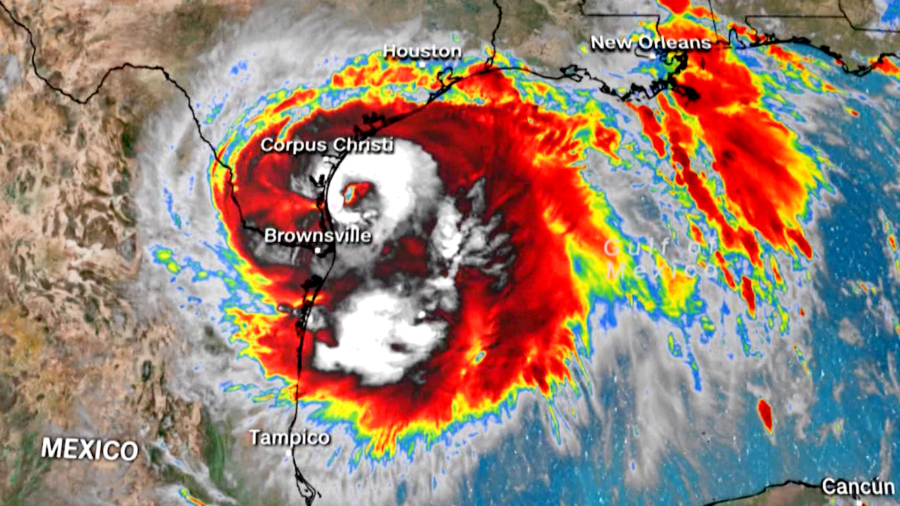CORPUS CHRISTI, Texas—A day after roaring ashore as a hurricane, Hanna lashed the Texas Gulf Coast on Sunday with high winds and drenching rains that destroyed boats, flooded streets, and knocked out power.
Downgraded to a tropical storm, Hanna hovered over the U.S.-Mexico border in the morning with winds near 50 mph (85 kph), the National Hurricane Center said. It was expected to unload as much as 18 inches of rain (45 centimeters) in parts of South Texas and northeastern Mexico.
Border communities whose health care systems were already strained by COVID-19 cases—with some patients being airlifted to larger cities—found themselves grappling with Hanna.
Dr. Ivan Melendez, the health authority in Hidalgo County, Texas, was treating a patient overnight at a hospital when he noticed water pooling on the floor.
“I thought, ‘Hey, something’s leaking,’” Melendez said. “The nurse looks at me and says, ‘Look behind you.’ I look and see this water coming and coming and coming down the wall.”
The water was flowing through a vent in the room, which had been retrofitted with a fan to create negative pressure and prevent the virus spreading through the hospital.
After driving home in the storm in the middle of the night, Melendez was trapped Sunday morning in his home by downed trees and had no electricity. He used the phone to discuss whether to place a 58-year-old woman on a ventilator, a decision he felt uncomfortable making without seeing the patient in person.
“You look at the people’s eyes,” he said. “You’ll know if they’re in despair.”
Shelters were opened in hotels, schools, and gyms. A community building known as the “Dome” in the border town of Mercedes was set aside for evacuees who had tested positive for COVID-19 or were exposed to the virus. Authorities instructed people to bring masks and hand sanitizer if they could.

Coastal states scrambled this spring to adjust emergency hurricane plans to account for the virus, and Hanna was the first big test.
Gov. Greg Abbott said Saturday that some people in need of shelter would be given hotel rooms to keep them apart from others.
“We cannot allow this hurricane to lead to a more catastrophically deadly event by stoking additional spread of COVID-19 that could lead to fatalities,” he said.
The first hurricane of the 2020 Atlantic season blew ashore as a Category 1 storm late Saturday afternoon with winds of 90 mph (145 kph) not far from Port Mansfield, which is about 130 miles (210 kilometers) south of Corpus Christi.
Parts of South Texas had gotten at least 9 inches (23 centimeters) of rain, including Cameron County, which includes Brownsville.

Myrle Tucker, 83, tried to ride out the storm in a powerboat docked in a Corpus Christi marina. But winds and rain blew out the vessel’s windows. Eventually, rescuers in a dinghy were able to reach him and bring him to shore.
Tucker was standing in the marina Sunday holding a cup of coffee. Many other boats had been flooded and lashed by the storm. He recalled telling the rescuers he wasn’t sure he would be able to climb out of his boat.
“They picked me up,” he said. “They carried me like a box of napkins.”
The Coast Guard helped rescue a couple without injuries after their sailboat began taking on water Saturday evening in a harbor near Corpus Christi.
More than 180,000 customers were without power Sunday morning throughout South Texas, including Corpus Christi, Harlingen, and Brownsville, according to AEP Texas.
Corpus Christi is in Nueces County, where health officials made headlines when they revealed that 60 babies tested positive for COVID-19 from July 1 to July 16. Farther south in Cameron County, more than 300 new cases have been reported almost daily for the past two weeks. The past week has also been the county’s deadliest of the pandemic.
Hanna came nearly three years after Hurricane Harvey blew ashore northeast of Corpus Christi. Hanna was not expected to be as destructive as Harvey, which killed 68 people and caused an estimated $125 billion in damage in Texas.
By John L. Mone and Nomaan Merchant


